Back to the Future - SUL - 7.65 ounce Polarguard-Delta - Silk Tunic / Quilt
7 ounce Polarguard-Delta - Silk Tunic / Quilt
Written 08/27/2006.
This thread was first posted at BackpackingLight.com and the full thread with all comments can be seen here:
http://www.backpackinglight.com/cgi-bin/backpackinglight/forums/thread_display.html?forum_thread_id=3932
1.
I have been playing with the math for a very light quilt that will be NO larger than necessary for my size. Unlike some folks that are not as tall and wear smaller sized cloths and shoes, I am 6' tall with long arms (think XL upper body garments) and wear a size 11 trail runner. Anyone that wears larger than a size medium and size 9 shoe should get some kind of "handicap" like golfers get. I know that this has been talked about by some of our SUL Hikers and someone we all know was once so generous that he let a taller person hiking with him take (ONE OUNCE) off his weight total.
How it all starts:

Before starting this Quilt I looked at as many different ideas for quilts as I could and read about what others were using. I spend a lot of time planning my projects and do a lot on paper before I cut material. For this quilt I spent a couple days working out all sorts of different ideas for the size I needed and the material weighs. My weight goal is 7 ounces or less. I am using 1.9 oz per sq yard Polarguard Delta as my insulation. For the fabric I am using Cuben and light Silk. This is the only combination I have materials for that will give me the low weight I am after. I don't know how the Cuben will work used like this but I will find out on my hike in October. The Cuben will be on the outside and I think it will work OK.
This afternoon I started the Prototype. For this Quilt I am making my Prototype out of some $1 a yard denim from Wal-Mart. You can see a lot of lines on my material as I made different changes right up to the time I cut the material. I expect this quilt to be on the easy side vs some things I have made. The time I spend on the Prototype will make the finished Quilt go fast.
Prototype:

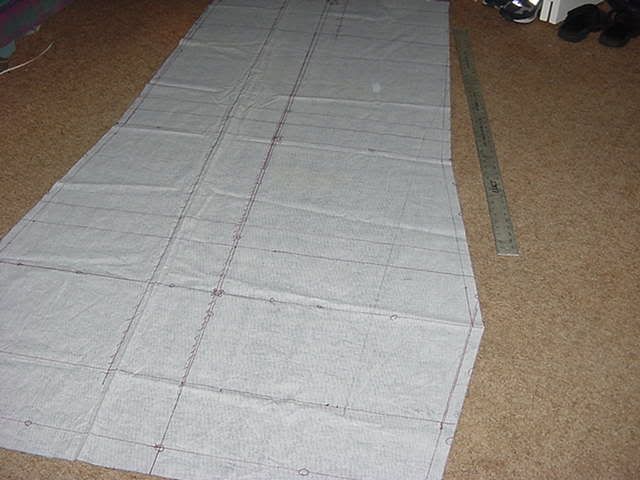
2.
The issue of the using the Cuben material has plagued me ever since I thought it was the only way I could stay under the 7 ounce goal I have set. I have been scheming for a way around the Cuben material ever since I posted the remark about using it. If I expected to be cold enough for a vapor barrier to work the place for the Cuben would be on the bottom. One layer of PG - Delta or Climashield XP would not keep me warm alone if it gets very cold. What I want is something for a temperature range down to maybe 45 to 50 degrees. My pick of clothing would support my sleeping system and I could go to "Down". I have a few reasons why I want to try one of the two synthetic insulations listed.
The end result of working through this all afternoon and up till a hour or so ago is that I have "Down-Sized" the Quilt a little more. I have some Pertex Quantam and have gotten the Quilt "square yardage required" down enough to go with the Pertex Quantam for the top and Silk for the bottom. Adding one layer of the 1.9 oz PG - Delta brings the total material weight (on paper) for the Quilt to 6.46 ounces. This gives me a little extra for the other things necessary and should still stay under my 7 oz goal.
I have a bit of Climashield XP and it is easy to buy in small amounts. Being a new generation insulation, when dry it is a much better insulation than PolarGuard Delta. As more Climashield XP is used it may prove better than PG-Delta when wet. However, for now if I think I might get wet I want my insulation to be PG-Delta. One of the things I want to do is make a quilt like this one but with Climashield XP. Then I can do some testing for myself.
The question of how much or how thick the insulation needs to be for a given temperature when using one of these synthetics seems to be divided into several ideas. Down goes by loft and a synthetic goes by ??? This is where it gets interesting and I am not smart enough to really understand. That is why I want to do some of my own testing.
I am sure that my Cocoon top and bottoms are good much lower than 70F. I will be up in Georgia in October and if it is cold enough I will be able to see how warm I am with the Quilt and a few other things I am taking to test. I will not be far from a warm bed where I will be testing my stuff. Then if it seems to be good enough I will go on a hike for a couple of days. Still close enough to bail if I get to cold. I use the old indian way to see what the rating of my insulated stuff is, am I warm in it, yes or no. How much other stuff do I need to put on to get warm. Do I need to go to a warm house now.
3.
How to figure the amount of synthetic insulation needed for a given temperature range.
Note: Like working with Down these are "ball-park" numbers and field testing should be done to test the amount YOU need for any given temperature.
I have both Polarguard Delta (PG-D) and Climashield XP (C-XP) synthetic insulation. The information I have for the Clo value of the the PG-D and the C-XP came from Brian Emanuel, Director of Sales for "Western Nonwovens" the company that makes both of these two products. The Clo for PG-D is .67 to .68. The Clo for C-XP is .77. To get an idea of the temperature range for something made from one of these (this is a ball-park number) you weigh a sample piece of the insulation. I cut a 6" square of each and weighed them on my gram scale. the PG-D I have came out 1.9 ounces per sq yard. The C-XP came out 2.41. The PG-D was about between 1/2" to 5/8" thick. The C-XP was 3/4" plus a bit.
Working first with the PG-D I take the weight per sq yard of 1.9 ounces and multiply that times the Clo of .68 and get 1.292 . This number equates more or less to the typical loft rating like we use with Down. With 1.292" (for want of a better word) loft and looking at the table in "2006 Revision by Mike Martin -Backpacking Light Position Statement on Sleeping Bag Temperature Ratings" it would seem that this would give me a bottom temperature range of 50 degrees "F". We all know that this type of rating is just a base line and maybe high or low for any given person. It does provide us with a number to work with.
When I did the math for the C-XP at 2.41 ounces per sq yard times .77 I get 1.848" loft??. The extra weight of the C-XP (0.51 oz per sq yard) gives me 0.556" more loft per sq yard of insulation. With one layer of this C-XP my base line temperature low should be 30 degrees "F".
What can I do with this information? Well, if my new quilt was made with PD-D I might be able to use it down to 50 degrees "F" ???. If I wanted to use C-XP I would only add 0.97 ounces and might have a low temperature range of 30 degrees "F" ???. Add less than 1 ounce total weight and gain 20 more degrees "F" ??.
That would give me a 7 ounce quilt good for maybe 50 degrees or an under 8 ounce quilt good for maybe 30 degrees.
Interesting, but how do I test this to see if my numbers are in the "ball-park". I expect I need to make two quilts off the same pattern, one with PG-D and one with C-XP.
4.
I can not backup in court anything I wrote in my thread. That is why I added the ???. When asked point blank about the use of the Down chart I was told to realize that a whole lot goes into a rating like for a sleeping bag or what ever before it goes on the market. In other words it is hard to be real certain because of other factors. Type of shell material, type of lining, type of construction etc. I was told that the Down loft chart for Down stuff is only a "maybe" at best for the same reasons. It does however give a person a starting point. These folks product a material (PG-D, P-XP and others) that (BMW, TNF etc) combine with more material and design considerations to market a product.
But that if I error on the conservative side, the way I wrote in my post the number should be good enough for planning/testing. Testing is the key. You may also note that I added "ball-park numbers" several times.
I asked them to look at the other thread where the Clo was talked about. I was told that the other idea for the math was wrong. That is all I want to say about that.
I asked the same question about Down vs this insulation but could not get a real answer. I did get that PG Delta is really great if you expect it to get wet. Not enough testing has been done with the C-XP yet or no one is talking about it to say if it is better, yet. I was really surprised that I was given as much information as I was. They said over and over that the new stuff they are making today is good, really good. That XP is the best synthetic insulation on the market but it is new and it will take a year or so to prove itself.
It may be that this new generation of synthetic insulation will come close to closing the gap with Down. I don't know. For me it is mostly about weight and if I expect to get wet. I really love Down, most everything I own to keep me really warm is down.
As for a direct equivalent to Down, I don't know. I asked for some "ball-park" numbers.
My one layer quilt might be OK to 55 degrees.
40 degrees about a Clo of 2 to 2.5.
20 degrees about a Clo of 3 to 4.
0 degrees about a Clo of 6.
For most of the answers to these and other like question WE may have to be the ones to prove or disprove what it takes to stay warm with this stuff. The big guys may never want to talk about it.
5.
If you look on the Climashield XP part of the web site at www.westernnonwovens.com the Data sheet list 5 thickness for XP. The data sheet lists the following:
2.2 oz per sq yard.
3.0 oz per sq yard.
4.0 oz per sq yard.
5.0 oz per sq yard.
6.0 oz per sq yard.
My guess is that what they list as 2.2 oz is what I have but weighed 2.41 oz per sq yard. I think Thru-Hiker has more than one thickness of XP.
Don't give up, the availability of PG-D might get better for us little guys.
6.
I agree that the weight of my sample piece may not be true for the full amount of the Climashield XP or Polarguard Delta that I have. It does however give me an idea of the weight for planning purpose. As I start cutting the material that I use for my projects I weigh and record them to confirm I am close to my planning numbers or I am high or low. Then when I am finished with the (what-ever- project) I weigh it again for my finial finished weight. My scale is a Triple Beam Balance - Ohaus gram scale.
As for "your" term not mine of " REAL WEIGHT" all I said is that:
"I cut a 6" square of each and weighed them on my gram scale. the PG-D I have came out 1.9 ounces per sq yard. The C-XP came out 2.41. The PG-D was about between 1/2" to 5/8" thick. The C-XP was 3/4" plus a bit. "
Anyone but a lawyer should have taken that to mean I took a "sample" and weighed it.
The numbers are only important to ME at this point and give ME numbers for planning the amount of material necessary to reach my given weight goal. Am I misleading myself? I would expect anyone that wants to work with this stuff would sample what they have for "planning" numbers also.
7.
I have settled on a prototype for my first real quilt. I even slept in it last night to see if it was going to be large enough. It fits OK and is about as small as I think would work for my size.
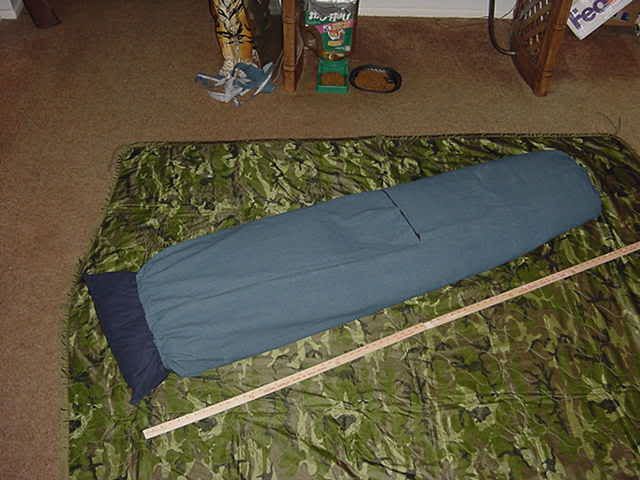
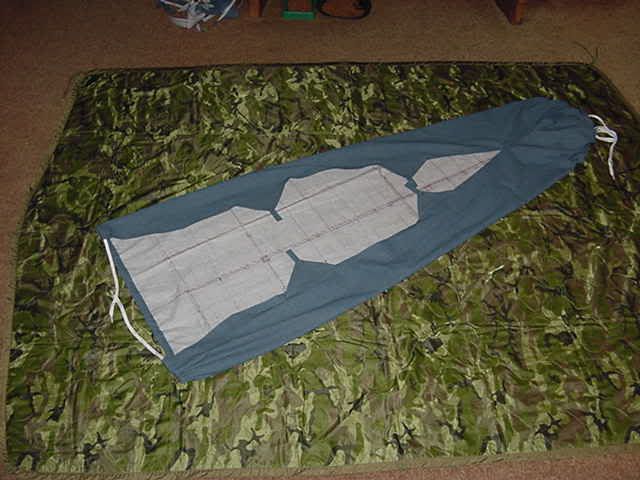
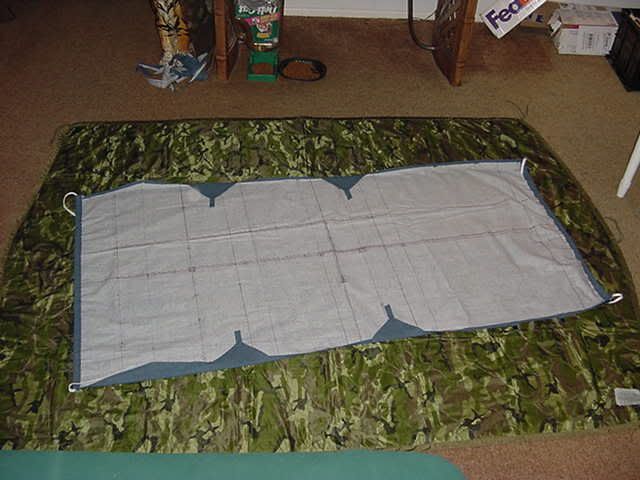
I even got out my Pertex Quantum and box of Polarguard Delta.

I had thought about dying the silk I am using for the liner but I think I will leave it white.
If I can stay focused on the quilt tomorrow I should get most or maybe all of it done.
8.
As for the triangular base things, yes I hope and how about when I wear the quilt as a garment?
If this works where do I count the weight?

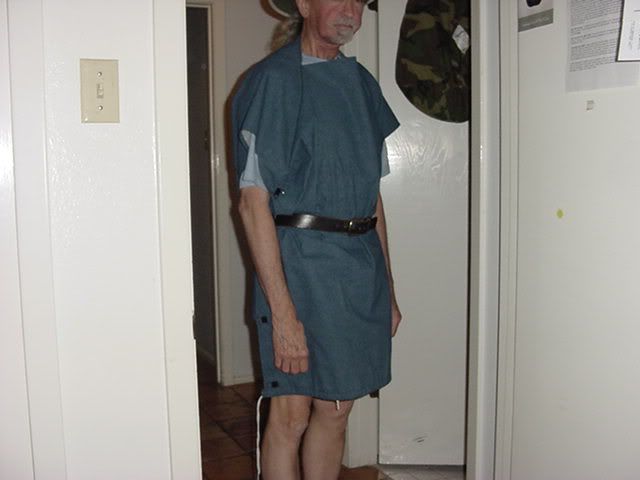
9.
I did this drawing and scanned it.
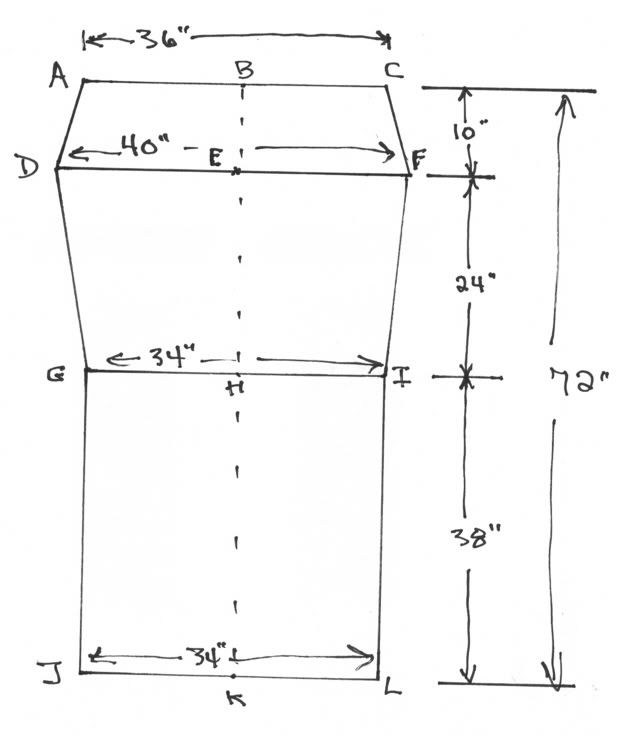
10.
Cutting "My Precious" :
Well that part went easy.


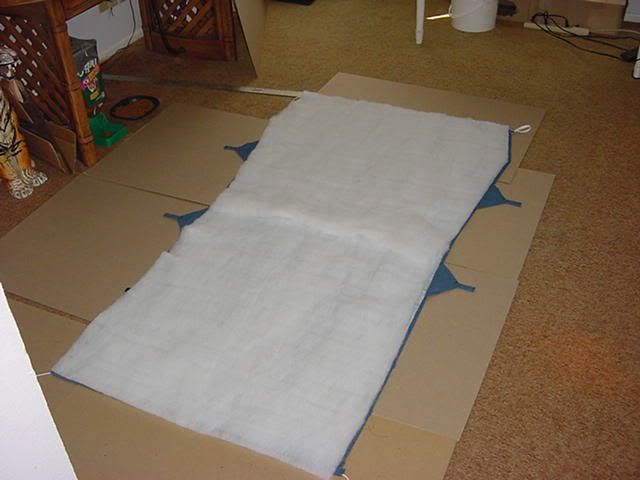
11.
Brian Emanuel
Re: 7 ounce Polarguard-Delta Quilt-etc on 08/30/2006 19:45:27 MDT
Very interesting thread regarding Climashield XP and Polarguard Delta. I am the Sales Director for both Polarguard and Climashield. Beyond a doubt XP is lighter than Delta. Standard testing protocol for basis weight is to weigh a piece 36" x 36". This weight in ounces gives the ounces per square yard of the batting. Regarding temperature ratings, for a given ounce per square yard XP will have a better temperature rating than Delta (~7%). The advantage is you can get a given temperature rating at a lower weight with XP versus Delta. However, Delta will have a higher loft than XP for a given basis weight. We could discuss theory throughout eternity in regards to the impact of loft on temperature rating. Bottom line is that this is a multi-variant optimization in terms of thermodynamic mechanisms (conductive, convective and radiative heat transfer mechanisms). Also, the true temperature rating is highly contingent upon bag/quilt/garment construction as well as shell and lining materials. There's a lot of science involved but it's still mainly an art. Both products, XP and Delta, are exceptional synthetic insualations and from my perspective the best two on the market today. Both are continuous filament so the durability is unsurpassed and even after numerous uses, launderings or prolonged storage they will recover and perform as well as the first time! If you are looking for ultralight weight synthetics we are currently working on a new product, Climashield Combat, that will become available in weights as low as 2.0 ounces per square yard. Good luck with all your efforts!
12.
It sure was nice seeing Brian's comments. I have talked to Brian on the phone several times. He was very nice and took a lot of his time explaining the merits of both types of insulation. I hope to make a number of insulated items out of both the PG-Delta and the Climashield XP.
The best part of all this is that Climashield XP is available in amounts of a yard or more from Thru-Hiker.com. It also is nice to see that Ryan thinks he will have some Polarguard Delta available for MYOG folks this fall.
13.
Richard Nisley:
Now for the controversial part
Insulation clo/oz % loft when wet
Polarguard Delta .68 -40
Primaloft Sport .74 -11
Climashield XP .77 -??
Primaloft One .84 -00
500 fill down 4.5 -60
800 fill down 2.5 -60
Would you investigate a DIY source for Primaloft One? It would be the optimal solution for wet environments. Brian’s counterpart for Primaloft is Arnie Liati in the Primaloft Issaquah, WA office.
Would you let us know what quilt weight you could achieve using 800 fill down for your quilt? It is available from multiple sources and has a much better clo/oz value for dry environments.
My experience with synthetic bags is that I get about a 40% reduction in loft after one season’s use and then they stabilize at that loft. The temperature rating drops and stabilizes accordingly. I haven’t experienced more than 10% degradation in my down bags after multiple years of use. No one on the BPL forums has ever compared the loft degradation history between various synthetics. Would you monitor the loft degradation with your quilt experiments?
From your conversations with the Polarguard folks do you know what the Climashield XP loft reduction is when wet?
You continue to amaze me at the way you think outside the box to innovate. This area is ripe for someone to shake it up with some new ideas.
1. Q - Would you investigate a DIY source for Primaloft One? It would be the optimal solution for wet environments. Brian’s counterpart for Primaloft is Arnie Liati in the Primaloft Issaquah, WA office.
1. A - I could not find anyone that was retailing PL-One. I decided to call PrimaLoft and see what it takes to buy direct from them. I finally found a little time to call and ask. I filled out a form for them and asked about getting a sample of PL - One 1.8 ounce a sq yard insulation. I have had a 5 yard sample request approved and it should be shipped next week. I asked about buying some and pricing but was asked to wait till next week for that answer. They have a one roll (45 yards) minimum if they agree to sell to me. I will wait till I can make a few things with the sample and test them before I buy any if they agree to sell to me. The sample will be enough to make several items to test / compare with the other insulation I have. I will make a Quilt / Liner for my Bivy with some of the PL-1, 1.8 oz a sq yard material so I can do a direct comparison with my other Quilts / Liners.
I want to do more with the Climashield Combat as I have been surprised (good surprise) with that insulation.
2. Q - Would you let us know what quilt weight you could achieve using 800 fill down for your quilt? It is available from multiple sources and has a much better clo/oz value for dry environments.
2. A - I did a little math to see what the answer to this might be but I need to work on it a little more. I need to figure out the sewing for sewn baffles. The way I have worked with Down in the past was with a removable baffle or side-in silk tube of Down. Doing it that way let me use the Down Tubes for other things but did add a little weight. I need to practice making the baffles a different way and when I work that out I can then weigh the material and add the Down weight for a "best guess" answer. It would seem that the Down Quilt / Liner has to be lighter by a bit. The difference might be an ounce or so over the current Quilts / Liners that weigh 6.5 to 7.5 ounces. The total weight for a Down Quilt same size, same Temp range (40 degrees F) might be as low as 6 ounces using my light silk as the shell and liner material.
3. Q - My experience with synthetic bags is that I get about a 40% reduction in loft after one season’s use and then they stabilize at that loft. The temperature rating drops and stabilizes accordingly. I haven’t experienced more than 10% degradation in my down bags after multiple years of use. No one on the BPL forums has ever compared the loft degradation history between various synthetics. Would you monitor the loft degradation with your quilt experiments?
3. A - I don't know how I will do this but I will try an watch what happens over time.
4. Q - From your conversations with the Polarguard folks do you know what the Climashield XP loft reduction is when wet?
4. A - The next time I have a chance to talk to someone like Brian I will ask about this and see what they say.
14.
I funny thing happened on the way to my 7 oz Polarguard Delta Quilt.
Once I cut the Polarguard Delta to the shape of my Quilt I put it on my scale. My planned for weight was 3.69 ounces. My 1.94 sq yards of Polarguard Delta weighed 4.29 ounces. The center part of the insulation was thicker and looked like somewhere in the process it may have lifted some insulation from the layer above or below it when it was made. Beyond that I have no real idea. The good news is that if I use this piece of Delta my per square yard weight is 2.21 ounces. This times the Delta Clo of .68 gives me a number of 1.503 (inches or what ever). That would make the Quilt warmer than planned for by a small amount. If I was using Down in the Quilt and had a loft of 1.5" I would say it would be good somewhere between 40 and 50 degrees (F).
I spent the next several hours crunching the numbers. I even tried a smaller Quilt size. I made a full size cloth prototype. It was sized to come up only to my arm pits. It did that OK but I didn't think it would work for me.
In all my number crunching the only material I have that would still get me close to the 7 ounce mark was some of my light silk. Using 4.5 mm silk (0.57 oz per sq yard) for both the top and bottom I would be over 7 oz by a .5 to .75 of an ounce. That assumed no other surprises.
I finished the Quilt a little while ago. It weighs 7.65 ounces. Accounting for the extra 0.60 ounces of extra PG - Delta I should be happy. I will have a Quilt that will be warmer by a factor of 1.5 over 1.3. It fits me snug with the foot box closed. In my Hammock the foot box as well as the complete right side of the Quilt will be connected to the right side of the Hammock. I think the Quilt will be OK on the ground as a sleep on my back. I got in it to see how the fit was and began to get warm fast. It is 74 degrees in my bedroom.
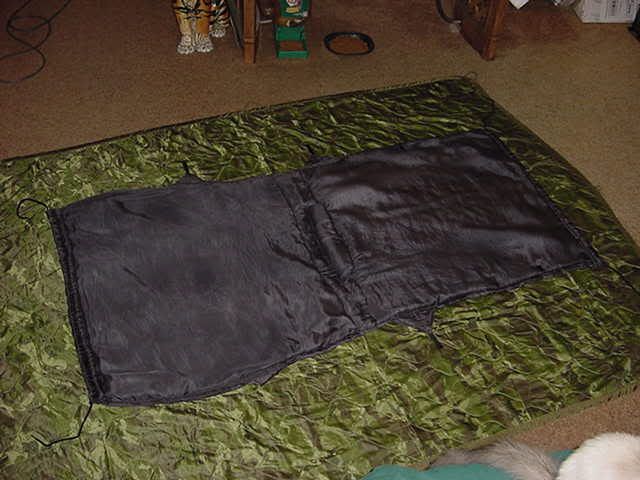
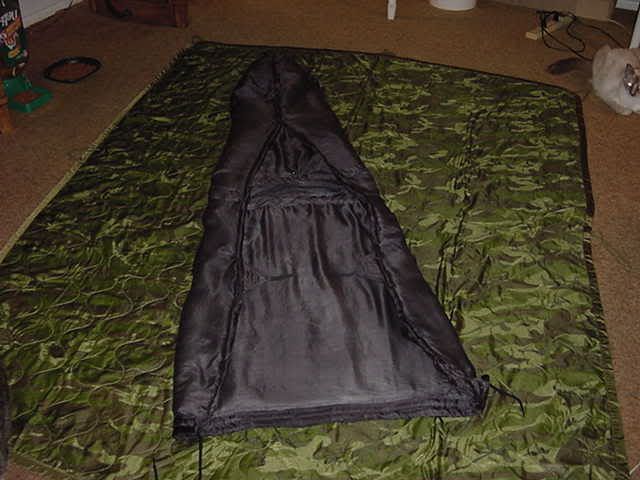
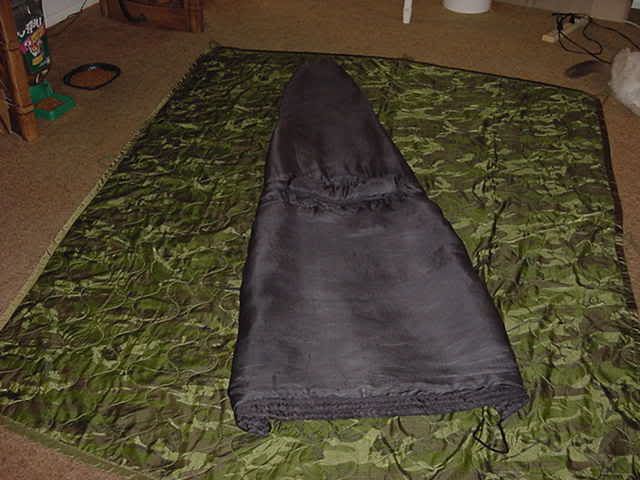
I really learned a lot about sewing a Quilt. I think I over sewed much more than might have been necessary. I believe I could now make another Quilt from the same pattern and save some weight with less sewing. I should say sewing the Quilt differently.
I did design this Quilt so I can wear it and for a SUL Gear List for cool weather it should do double duty. I think the extra sewing for the head hole accounted for a little of the extra weight.
Weight Breakout:
PG-Delta - 4.29 oz
Silk for Shell and Liner - 2.22 0z
Other - 1.14 - oz
Current Total Weigh - 7.65 oz
When I make the next Quilt I will weigh all the necessary insulation first and see what it weighs. Then decide what to use as Shell and Liner material.
15.
Some better pictures:


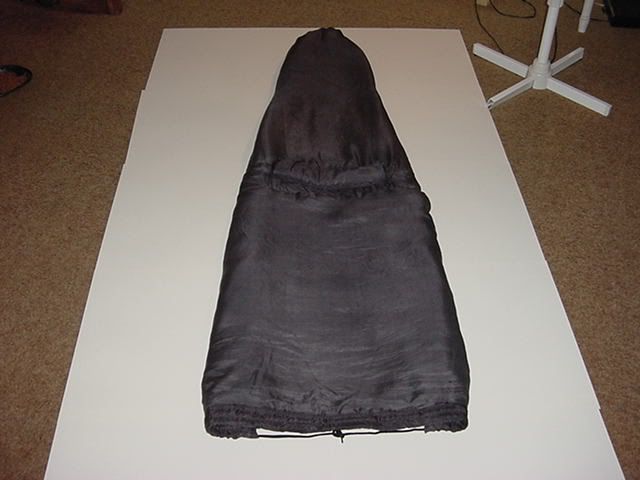
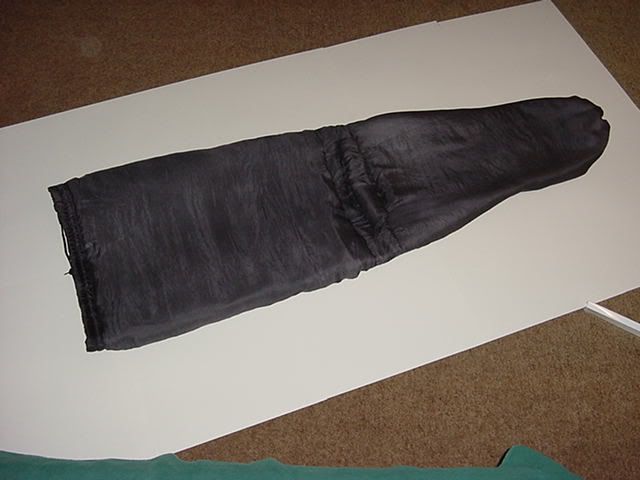
16.
First let me say I really hate Velcro and "almost" never use it.
The foot box is connect with three pairs of hook like things. Then if you see the triangle looking things sewn into the side seams - they will connect to the ones on the other side of the Quilt and hold the Quilt more or less to a sleeping pad. In my case to my Kilt/CheerStic Air Pad "thingy" or what ever I happen to use. The Quilt will also be used in my Spreader Bar Hammock and the Hook things for the foot box will connect the foot end of the Quilt to the foot end of my Hammock. The side triangle things will connect also to the sides of my Hammock. I was going to work that out this afternoon in my backyard but we had a little rain.
I have a BMW Vapr Bivy Sack (Pertex Quantum) at about 6.5 ounces that I think I can put this all inside if I need to for "a moderately-hermetic seal against the night air". I haven't tried this yet and if I don't have enough room I will make my own bivy out of Cuben and Pertex Quantum. I will test this in my backyard and then again in Georgia next month to see how it works in cooler weather. I will take and post some pictures of this all together.
The end game here is a Sub 2-lb, Sub 3-lb, Sub 4-lb set of gear lists. Heavier when cooler - lighter when possible.
17.
My quilts are made to be used inside my Bivy. This holds the edges of the quilt next to me or under me a few inches. I don't move much when I sleep and sleep most of the time on my back.
I am taller than you as I am 6' tall but my current weight is only about 145. I measured around my shoulders and came up with 47". This really isn't much of a difference between you and I except for the height.
When it is cold I use my Down Air Mattress (DAM) inside a Bivy. I haven't tried my new Bivy with the DAM inside it other than to see if it would fit. It fits fine.
18.
I was wearing my Tunic/Quilt around the house last week when the ice storm caused a power outage. My power was off for 20.5 hours back on for about an hour and then back off for 4 more hours. The Tunic / Quilt was just right.
19.
Springer Mt - GA - AT. Oct 2006 The temperature was 35 degrees that morning.
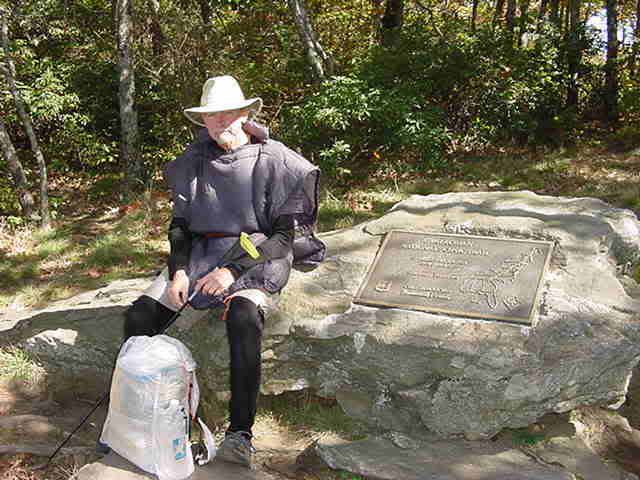
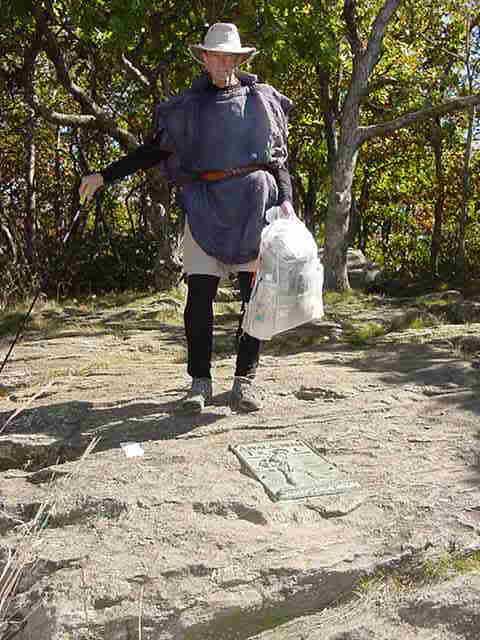
Along the Duncan Ridge Trail, GA - Oct 2006



1 Comments:
こんにちわ、JSBです
お休み処blogに、訪問していただき
ありがとうございます!
日本にも、伝統寝具「かいまき布団」が
あります。ガウンの前後をわざと逆にして
寝るときだけに使います。一例です。
http://item.rakuten.co.jp/mediaprice/2467500000001/
袖の部分の重さで、上の布団が動きにくくなる効果があります。一般的ではありませんが
暖かい寝具の一つです。
Post a Comment
<< Home